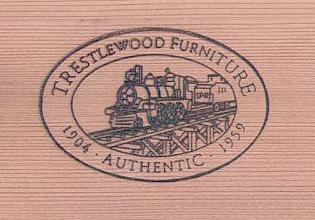
 The Trestlewood Furniture Story
The Trestlewood Furniture StoryA good deal of my time growing up was spent out and around the lake. My friends and I had built a small motor boat specially equipped for salt water with an air-cooled engine and epoxy painted hull, which we used for exploring the numerous islands; by foot we hunted birds in the marshes, explored Indian caves around the shores, found petroglyphs or searched around the ruins of the old Saltair Resort. Exploring the North end of the lake always brought us within view of a beautiful old wooden trestle. Little did I know then that this trestle would figure prominently in my adult life.
The North end of the lake is the site of the Golden Spike - the final meeting place of the trans-continental railroad. It is also the place where, in 1901, Southern Pacific began construction of the Lucin Cut-off, as it was called, a line that ran from Ogden straight over the lake on a trestle nearly twelve miles long, then over the desert flats, one hundred and two miles in all, to Lucin where it rejoins the old road.
On the 18th of September, 1904, the new line was opened and the Cut-off carried its first train traffic. The 12 miles of wood trestle were an engineering marvel. Building it took 3,000 men more than three grueling years working in extreme summer heat and freezing winter cold. Forty-three miles of slow, dangerous grades and curves through the mountains north of the lake were lopped off by this straight new route across it.
When I heard that the trestle (taken out of service in 1959) was being salvaged, I immediately left work and drove out to the North end of the lake to check it out. We often use salvaged and reclaimed materials on some of our construction projects, so it interested me from that point of view, but it also brought me back 30 years to my days on and around the lake, exploring the North end in that little home-made boat. It was a cold January day and the salvage operations had begun about month earlier. Some of the tracks had come off and a few of the bents had been removed. It was beautiful Douglas Fir, and plenty of it. I quickly estimated there to be about 40 million board feet. In the foreman's trailer was a coat rack, made from a piece of wood from the trestle. It was redwood, and had the most beautiful deep, rich grain I'd ever seen. The foreman said that the entire 12 miles of the trestle's deck was redwood, in sizes about 3" thick by 6 - 12" wide by 10 - 20' long.
I got very excited and asked if he had any of the redwood. He didn't at that time but promised to send me some as salvaging progressed. I received a call less than a year later and was invited up to Blackfoot, Idaho where the salvage company now had stockpiled a fair amount of redwood. I flew in and spent a day going over the milling and processing operations. Since it formed the trestle's deck it had spike holes, tar and numerous embedded nails and rocks. Processing was quite a challenge.
I purchased some wood; the Ogden Nature Center in Ogden, Utah was our first project utilizing the trestle wood. The building's major structural elements are constructed from fir pilings and cross-bracing from the trestle's bents; the entire structure is sided with redwood from the trestle's planking. During this project I realized that smaller pieces, unsuitable for construction, were regrettably being discarded. It seemed a shame to cast off this beautiful wood with such a fascinating history.
Then one day I hit upon the idea of outdoor furniture. Larry Zbinden, one of my supervisors, designed some prototypes which he and Chris Wright, my cabinet shop foreman, worked and reworked into our current product line. This beautiful wood which once bore the weight of trains laden with passengers and freight steaming into the West, is now available for use in your garden or patio from the Trestlewood Furniture Company.